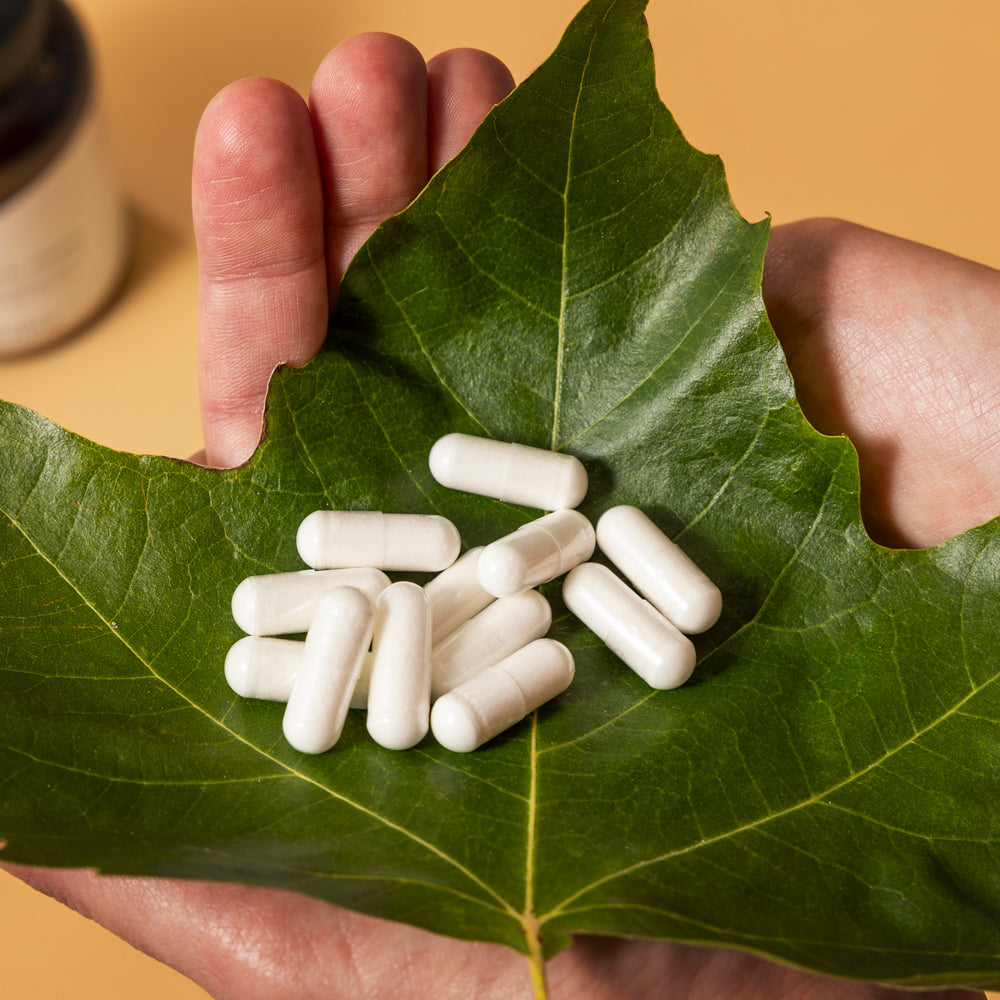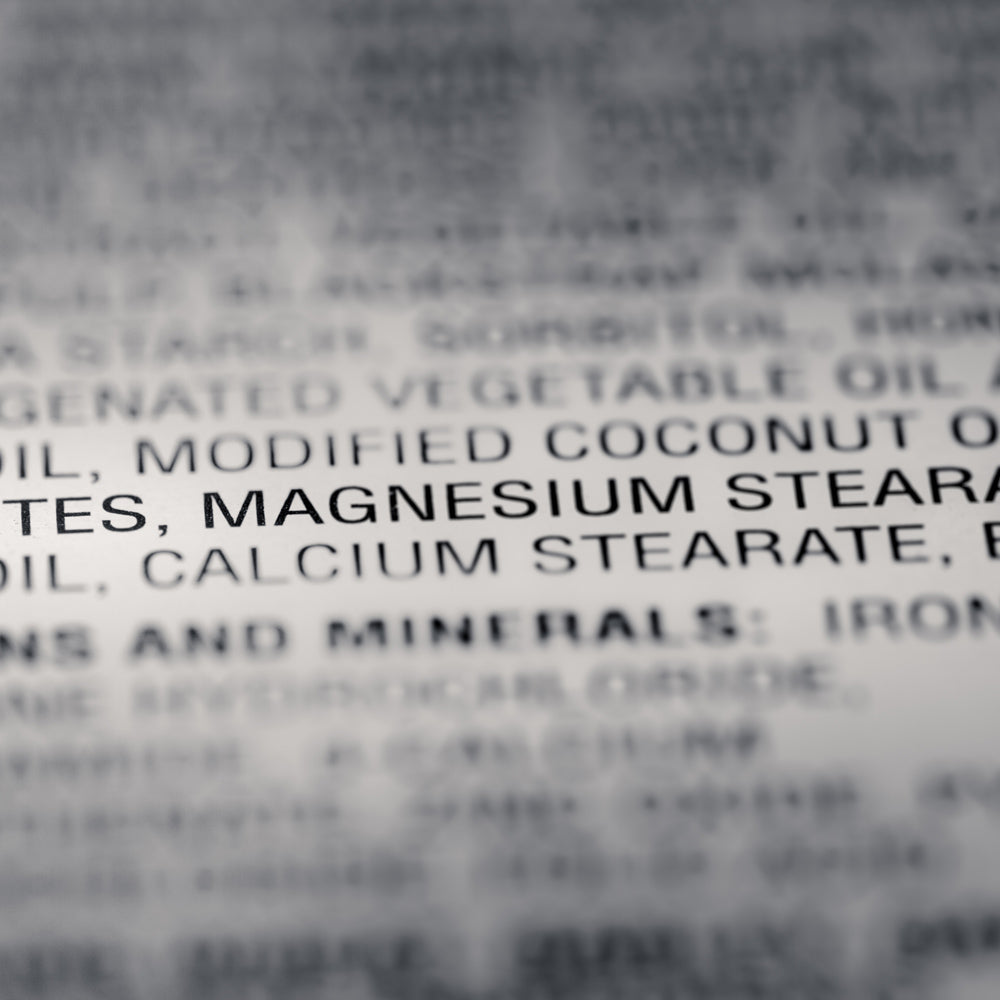
Pure by Design
In today's world of mass-produced supplements, what you put into your body matters more than ever.
Examine the label of most supplements today and you'll likely discover ingredients such as magnesium stearate, microcrystalline cellulose, silicon dioxide, titanium dioxide, carnauba wax, calcium carbonate, polyvinyl alcohol, polysorbate, talc, to name but a few.
These substances, collectively known as excipients (which include fillers, binders and additives), are commonly used in manufacturing but serve no nutritional purpose.
At Puramins, we take a fundamentally different approach. Every decision in our manufacturing process is guided by a single principle: to deliver supplements in their purest, most effective form. This means carefully selecting each ingredient not just for its benefits, but for how it works in harmony with your body.
Our Pure, Clean Formula Standards
No unnecessary fillers, binders, bulking agents or other additives
We never bulk out our formulas with inactive ingredients that serve no nutritional purpose, ensuring every component is beneficial.
No magnesium stearate or flow agents
We avoid manufacturing shortcuts like magnesium stearate that most other brands use to speed up production and reduce costs (1).
No HPMC capsules
Otherwise known as hydroxypropyl methylcellulose, hypromellose or 'vegetable cellulose', this a semi-synthetic, indigestible substance (2). We use pullulan instead for our capsules.
No artificial colours, flavours, preservatives or sweeteners
Pure supplements don't need artificial enhancements—we let the quality of our ingredients speak for themselves.
No gluten, wheat, dairy, soya, nuts, gelatine, trans fats or palm oil
Free from common allergens and controversial ingredients, making our supplements suitable for nearly everyone.
No GMOs or irradiation
We choose only naturally-sourced ingredients, never using genetic modification or radiation treatment in our products.

Why are Fillers, Binders and Additives Used?
Some excipients are used purely for practical reasons. For instance, when dealing with very small quantities of active ingredients—like vitamin D, where the daily requirement is microscopic—a carrier substance is needed to help distribute it evenly throughout the supplement.
For some excipients, such as magnesium stearate (discussed below), they can make production faster, more economical and thus increase profits, without regard for possible health issues.
While these substances are generally recognised as safe, they can pose concerns for some individuals. People may experience allergic reactions or gastrointestinal sensitivities to certain excipients (3,4). More importantly, these additives take up space in your supplements that could otherwise be used for beneficial, active ingredients.
At Puramins, our capsules are filled with only active ingredients. This allows us to maximise the space in each capsule for ingredients that actually benefit your health. If essential, any other ingredients are clearly listed on our label.

What is Magnesium Stearate?
Magnesium stearate is one of the most common additives in the supplement industry. Made of a white, powdery compound derived from stearic acid, which is a fatty acid found in various animal and vegetable fats. Despite its name, it contains very little magnesium and serves no nutritional purpose. Instead, it's used primarily as a manufacturing aid, acting as a lubricant that prevents ingredients from sticking to machinery and ensures smooth production flow (1).
While magnesium stearate is considered safe by major regulatory bodies like the European Food Safety Authority (EFSA) and the US Food and Drug Administration (FDA), questions have been raised about its regular consumption in supplements (5,6). Some studies suggest it could potentially affect nutrient absorption (7) though the evidence remains inconclusive (8,9). There have also been rare reports of allergic reactions, though these are uncommon (10).
The reality is that magnesium stearate isn't necessary for producing high-quality supplements—it's primarily used to speed up manufacturing and reduce costs. At Puramins, we've chosen to avoid it entirely, along with other flow agents and synthetic aids. This decision requires more time, expertise, and careful handling during production, but we believe it's worth the extra effort. Our manufacturing process may be more labour-intensive and result in higher production costs, but it allows us to deliver supplements in their purest form, containing only the active ingredients your body needs.
What is HPMC?
HPMC (hydroxypropyl methylcellulose), also known as hypromellose or vegetable cellulose, is a semi-synthetic polymer derived from cellulose (2).
While widely used in the supplement industry due to its plant-based origins, HPMC has several drawbacks. Its manufacturing process involves significant chemical modification and raises environmental concerns (11,12). Additionally, its high oxygen permeability can potentially compromise ingredient stability, which is why we prefer pullulan's superior protective properties (13,14,15).
We believe when it comes to your health, there should be no compromises on quality.
1) Morin G, Briens L. The effect of lubricants on powder flowability for pharmaceutical application. AAPS PharmSciTech. 2013 Sep;14(3):1158-68. Epub 2013 Jul 30. (https://pmc.ncbi.nlm.nih.gov/articles/PMC3755167/)
2) US Department of Agriculture. Hydroxypropyl Methylcellulose. (https://www.ams.usda.gov/sites/default/files/media/Hydroxpropyl%20Methylcellulose%20TR.pdf)
3) Balbani AP, Stelzer LB, Montovani JC. Pharmaceutical excipients and the information on drug labels. Braz J Otorhinolaryngol. 2006 May-Jun;72(3):400-6. (https://pubmed.ncbi.nlm.nih.gov/17119779/)
4) Pifferi G, Santoro P, Pedrani M. Quality and functionality of excipients. 1999. Il Farmaco,Volume 54, Issues 1–2, Pages 1-14. (https://www.sciencedirect.com/science/article/abs/pii/S0014827X98001013)
5) Tebbey PW, Buttke TM. Molecular basis for the immunosuppressive action of stearic acid on T cells. Immunology. 1990 Jul;70(3):379-84. Erratum in: Immunology 1990 Oct;71(2):306. (https://pmc.ncbi.nlm.nih.gov/articles/PMC1384169/)
6) Fujita M, Eda T, Anda T. Generation of Formaldehyde by Pharmaceutical Excipients and Its Absorption by Meglumine. 2009. (https://www.jstage.jst.go.jp/article/cpb/57/10/57_10_1096/_pdf)
7) Huang K, Cheng CL, Yang YK. Not all aspirin products have equivalent antiplatelet efficacy-Aspirin formulated with magnesium stearate is less effective in preventing ischemic stroke. Pharmacoepidemiol Drug Saf. 2020 Dec;29(12):1570-1578. (https://pubmed.ncbi.nlm.nih.gov/32954579/)
8) Hobbs CA, Saigo K, Koyanagi M, Hayashi SM. Magnesium stearate, a widely-used food additive, exhibits a lack of in vitro and in vivo genotoxic potential. Toxicol Rep. 2017 Oct 16;4:554-559. (https://pmc.ncbi.nlm.nih.gov/articles/PMC5655391/)
9) Søndergaard D, Meyer O, Würtzen G. Magnesium stearate given perorally to rats. A short term study. Toxicology. 1980;17(1):51-5. (https://pubmed.ncbi.nlm.nih.gov/7434368/)
10) Tammaro A, Abruzzese C, Narcisi A, Cortesi G, Persechino F, Parisella FR, Persechino S. Magnesium stearate: an underestimated allergen. J Biol Regul Homeost Agents. 2012 Oct Dec;26(4):783-4. (https://pubmed.ncbi.nlm.nih.gov/23241129/)
11) Hydroxypropylmethylcellulose. Science Direct (https://www.sciencedirect.com/topics/nursing-and-health-professions/hydroxypropylmethylcellulose)
12) United States Environmental Protection Agency. Cellulose Products Manufacturing: National Emission Standards for Hazardous Air Pollutants (NESHAP). (https://www.epa.gov/stationary-sources-air-pollution/cellulose-products-manufacturing-national-emission-standards)
13) Yang N, Chen H, Jin Z, Hou J, Zhang Y, Han H, Shen Y, Guo S. Moisture sorption and desorption properties of gelatin, HPMC and pullulan hard capsules, International Journal of Biological Macromolecules, Volume 159, Pages 659-666. 2020. (https://www.sciencedirect.com/science/article/abs/pii/S0141813020332621)
14) Across Biotech. HPMC vs Pullulan: Which Is Better For Capsules? (https://acrossbiotech.com/hpmc-vs-pullulan-which-is-better-for-capsules/)
15) Burdock G. Safety assessment of hydroxypropyl methylcellulose as a food ingredient. Food and Chemical Toxicology, Volume 45, Issue 12, Pages 2341-2351. 2007. (https://www.sciencedirect.com/science/article/abs/pii/S027869150700261X)